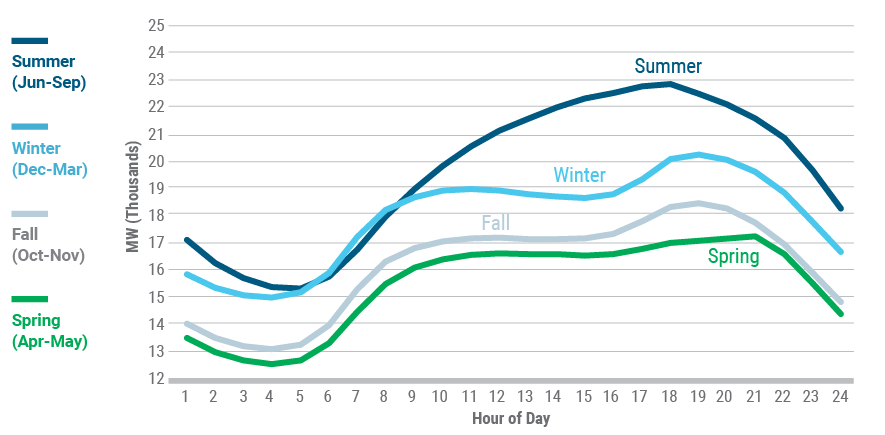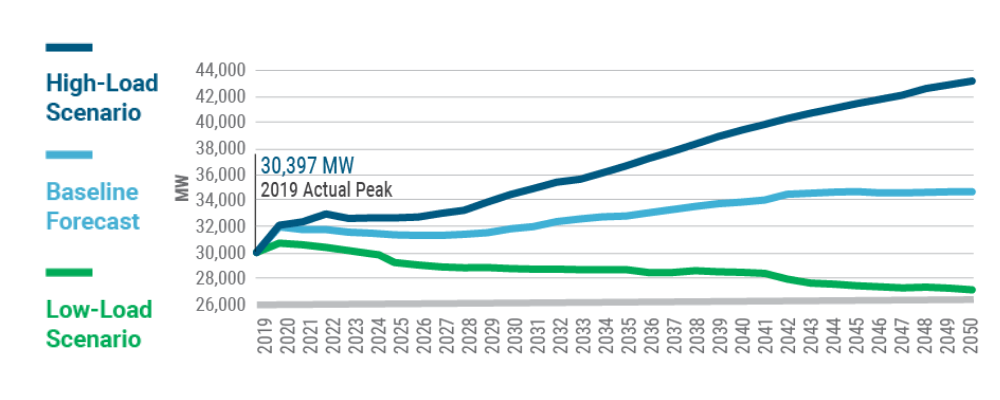Forecasting the Power Needs of the Future

Running the electric grid is a dedicated balance - generation always has to match demand to maintain reliability. So how do we know how much power is required at any given moment?
That’s where our forecasting analysts come in. The organization has five staffers whose job is to forecast upcoming power demands, from a day ahead to as much as 30 years ahead. They do this using advanced computer modeling systems that are based on historical power consumption patterns from the past 20 years and predicted trends for the next 30 years. Given the recent Climate Leadership and Community Protection Act and its milestones, particular attention is paid to the emission reduction and energy efficiency requirements called for through the coming decades.
The people who do this forecasting come from varying backgrounds. One studied meteorology and uses his weather expertise to inform his predictions. Heat waves, cold snaps, and severe storms in both summer and winter impact energy usage in many ways. Other team members have backgrounds in economics and statistics, or experience working for a utility.
Our dispatch of power generation and management of power flow in real time actually begins with the “day-ahead market,” 24 hours in advance. The expected load pattern that drives the day-ahead market is derived from several statistical computer models that forecast expected energy demand based on many factors. For instance:
What time of year is it?
-
Will it be sunny (more solar power) or hot (greater air conditioner use) or cold (greater heating needs)?
-
Are there storms forecasted that could damage power lines or results in a lightning strike on transmission equipment?
-
Is it a weekday or weekend, when more offices and factories are closed?
-
Are there any special events, such as holidays or the Super Bowl, which would result in changes to typical patterns of power consumption?

The day-ahead load forecast information is then used in the energy market managed by the NYISO for the purpose of setting power prices based on generating facility bids. And the forecasts are compared to the actual energy consumption patterns. Any necessary adjustments are then made to the forecast, as a part of the NYISO’s “real-time commitment and dispatch” processes. This helps maintain balance between generation and load on the power system.
But what about longer-term forecasts? Every year, we make long-term forecasts that look ahead up to 30 years. These long-term forecasts are based on end-use consumption and economic variables – population and gross domestic product trends, commercial and industrial employment projection, impacts from energy efficiency technologies, and such things as new appliances.

For instance, the growth of large-screen TVs in the early 2000s increased power demand, while more efficient air conditioners and light bulbs helped reduce it. The growth of distributed energy generation, from solar and wind resources to other behind-the-meter technologies such as combined heat and power, is also taken into account.
Of course, our experts can’t foresee everything. For instance, the recession a decade ago resulted in power consumption lower than forecasted, due to a drop in the economy. More recently, the COVID-19 pandemic reduced energy use and subsequent forecasting.
These long-term forecasts, prepared in collaboration with transmission owners, are used to understand future load patterns, and determine if changes to the New York electric grid are needed to enable future resources such as wind and solar while still keeping the lights on. This, in turn, can help inform the direction of public policy.
Arthur Maniaci, NYISO’s principal forecaster, said new technologies are always emerging that make predicting future demand increasingly difficult, such as the growth of energy storage and the growing popularity of electric vehicles (both of which add load when charging).
“That’s the challenge we are facing, both short-term and long-term, for figuring out what the electrical needs will be,” he said.
It’s our job to make the best forecast we can, based on the information we have. Check out our annual publication, Power Trends for the latest information on the electric grid.

